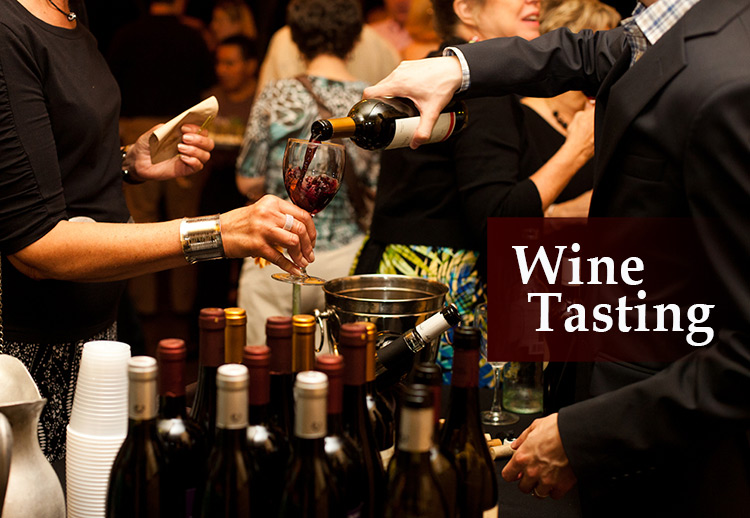Wine Tasting
 Ever seen people in eating establishments holding up their wine glasses above eye level and against the light in a concentrated gaze? How about people swirling their wine glasses constantly before and after every sip? And what about the repeated sniffing and whiffing before every drink? And the annoying gargling-like sound they make when tasting wine? These are not poor dining etiquette nor bad mannerisms. These are people in the so called ‘wine zone’ – the professional (or wannabe’s) wine drinkers.
Ever seen people in eating establishments holding up their wine glasses above eye level and against the light in a concentrated gaze? How about people swirling their wine glasses constantly before and after every sip? And what about the repeated sniffing and whiffing before every drink? And the annoying gargling-like sound they make when tasting wine? These are not poor dining etiquette nor bad mannerisms. These are people in the so called ‘wine zone’ – the professional (or wannabe’s) wine drinkers.
These people we ogle at curiously are simply performing the right ‘wine ritual’, no different from the tequila shots that always go with lemon twist and salt a.k.a. the ‘suck, lick and shoot’. These ‘rituals’ have important implications on real wine tasting. Now, let us examine the steps and analyze the significance of each. In doing this, we are actually going through what in wine jargon we term the ‘sensory evaluation’. The wine sensory evaluation is a five-step process we can term as 2S3T: short for Sight, Smell, Taste, Touch and Total Impression.
The Sight refers to the wine appearance. The wine could be best viewed if one picks up the wine glass by the stem or base. To get a clear picture, the wine glass should be held up to the light, or against a white background (against a white table napkin would do). Then observe the two factors of wine appearance: color and clarity. Color refers to the ‘color’ depth and hue of the wine. While clarity refers to the degree of ‘clarity’ a wine exhibits in a glass, that may range from brilliant (crystal clear), clear (translucent but not brilliant), to cloudy (muddled with sediments/opaque).
The Smell, or the olfactory sense refers to the aroma and bouquet of the wine. To begin this step, one has to swirl the wine glass to release the aromas, holding the glass just underneath your nose to inhale. Aroma can be described as the flavors associated with the grape fruit itself. This would mean the flavors characteristic of the individual grape varietals. On the other hand, bouquet can be described as the flavors influenced by the winemaker, and would include winemaking methods like oak aging, or malolactic fermentation (secondary fermentation). Some of these flavors are the vanilla effect of oak aging, or the buttery flavor influenced by the malolactic fermentation – these flavors did not come originally from the grape fruit.
The Taste literally refers to the taste of the wine. As a discipline, it is advisable to take a small amount of wine into your mouth. Draw in air into your mouth for a split second before swallowing. By aerating the wine in your mouth, you will be able to detect more of the wine flavor character (using rear nasal passage), while the swallowing gives you the impressions of sweet, bitter or acidic. It is also noteworthy that taste is said to be 80% smell, so the Smell and the Taste steps would most likely complement each other.
The Touch refers to the mouth feel or the wine texture – meaning how the wine `touches’ with your mouth, tongue and throat as you swallow. To make this effective, take a few sip of wine and concentrate on the wine’s `body’ and `finish’. The body of the wine can be light, medium or full –this is how wines are described on texture, from the thin watery feel or light body, up to the thick rich creamy texture feel or full body. On the other hand, the finish is described as the aftertaste, and can refer to the length of the wine, ranging from short to long, as flavors that end quickly to flavors that linger behind. The touch also conveys whether a wine finishes pleasantly or otherwise. Unpleasant finish may be on the poor wine balance (too acidic or too tannic), or other unsavory aftertaste.
Finally, Total Impression is the summary of your experience with wine covering the Sight, Smell, Taste and Touch components. It normally ends up with your personal rating of a wine, and the reasons why such rating is garnered. Find answers from simple questions of… Will you recommend this wine? Is this an excellent wine or a mediocre one? To the more probing question of… ”Are the Sight, Smell, Taste and Touch components of the wine coordinated?” Whatever the case may be, the answer is a total collaboration of your sensory evaluation. Now, any chance, you might still ridicule our professional wine drinkers on their rituals? Hopefully not anymore. By the way, we prefer these rituals to be called tasting techniques. With practice you can tell why these steps are great techniques in total wine tasting. Follow the 2S3T process, and open your realm of senses to the wonderful world of wine enjoyment. And please, wine moderately.
